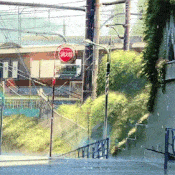|
Space-Bird posted:in my experience, people in SF complain about how 'cold' it is, whenever it gets below 70. I had a laugh over the weekend seeing californians wearing bubble jackets and other cold weather clothing when it was mid 60s on the peninsula. I guess getting slightly mild weather makes them dress up like it's winter at Lake Tahoe. Jerry Manderbilt posted:It's still noticeably warmer in the South Bay than in San Fran. The Tri Valley is probably the hottest before you actually cross into the Central Valley, though. It's not a scorching desert like the whiny 49ers were complaining, of course being loyal 49ers fans they were probably just looking for a good excuse to leave the stadium early.
|
|
|
|

|
| # ? May 24, 2024 11:48 |
enraged_camel posted:I'll take a dry 110F in Texas to a humid 90F in South Bay any day. In what insane backwards alternate reality is texas dry and the south bay humid? Aside from the desert part (where like 10 people live), Texas is a lot more humid than the Bay Area. Space-Bird posted:in my experience, people in SF complain about how 'cold' it is, whenever it gets below 70. I'm an SF native, and my happy zone is around 50-80 degrees. Get higher or lower than that and I get too hot or cold and turn into a whiny baby. Especially if it's really humid, gently caress that. Rah! fucked around with this message at 06:17 on Mar 12, 2015 |
|
|
|
|
enraged_camel posted:a dry 110F in Texas Someone doesn't know what Texas is actually like. Try 90+F at 60% humidity every day for at least 4 months straight. San Jose has nothing on Dallas (let alone Houston).
|
|
|
|
Rah! posted:I'm an SF native, and my happy zone is around 50-80 degrees. Get higher or lower than that and I get too hot or cold and turn into a whiny baby. Especially if it's really humid, gently caress that. yeah, 50-60 you can toss on a sweater and be comfortable, up to 80 a tshirt is nice and you don't feel like you're getting baked it was pretty hilarious when it was hitting 55-60 here in LA and i'm sweating in a t-shirt on the train because the train get's super hot, and there's folks in parkas and poo poo...like either they were somehow legit cold or were sweating buckets and too dumb to take a coat off.. i do kinda wish it was sweater weather all the time, i like sweaters..
|
|
|
|
Sunnyvale recently decided not to add a bus lane to a popular street and cut travel times in half. The reason they decided not to was because driverless cars will solve every's problems anyways so why even bother with public transportation. quote:The Sunnyvale City Council voted 4-3 last month to oppose dedicated bus lanes that could cut transit riders’ trips nearly in half along the length of El Camino Real, making bus trips almost as quick as driving. More than one council member said the city shouldn’t invest in transit because self-driving cars are going to make it irrelevant. http://sf.streetsblog.org/2015/03/10/fantasizing-about-self-driving-cars-sunnyvale-opposes-el-camino-bus-lanes/
|
|
|
|
 South Bay City Makes Terrible Urban Planning Decision South Bay City Makes Terrible Urban Planning Decision
|
|
|
|
Pervis posted:Typically yes, although the winds are sometimes different and so the South Bay will be just as hot as the Tri-Valley (especially if I'm living in the south bay with no A/C). The Tri-Valley doesn't get anywhere near as much smog though, as it's sort of a pcket. I used to drive from the Central Valley to work in the South Bay (without A/C), and it'd be 105-110 at home, driving past Tracy it's 115, and it'd drop ~10 degrees once I went over the Altamont to the Tri-Valley, another ~10 degrees once I crossed the Sunol grade, drop another 5-10 across 237 and then finally it'd be ~75 at work in Mountain View. The other big difference is how quickly, if at all, the temperature drops at night. The Central Valley basically sucks in July. My wife grew up in Morro Bay and she told me that it would be 68 and foggy at the beach and a 95 degree full-sun blaster 30 minutes away in Atascadero. (sp?) Geography and weather, man, It's weird. Like I'm not trying to be a panicky baby or overrepresent my level of concern but I'm kinda considering selling my real estate and moving out of So Cal. I don't want to live in the weather equivalent of 29 Palms and that's where this is going (not to mention being hosed on home equity, because LOL at anyone paying what I paid to live in an arid full-on desert drought-starved IE)
|
|
|
|
FCKGW posted:Sunnyvale recently decided not to add a bus lane to a popular street and cut travel times in half. Is this a good excuse to say "loving techies"?
|
|
|
|
appropriatemetaphor posted:i do kinda wish it was sweater weather all the time, i like sweaters.. Portland is calling your name. To be even shorter:
|
|
|
|
Jerry Manderbilt posted:Is this a good excuse to say "loving techies"? Eh... Most of those who voted against are actually your usual crop of entitled managers, self-proclaimed "inventors", and right-wing authoritarian assholes than software developers. Glenn Hendricks, is a senior engineering manager at PayPal (and former Marine, so that should tell you a lot right there), and Pat Meyering was almost subject to a recall election last year, for being a reported shithead as well. Oh, and Jim Davis is a former public safety officer, so you can probably guess his leanings. Meanwhile, two of the unmentioned council members who voted for the plan, Gustav Larsson and Jim Griffith, are supposedly actual software engineers, so I think it's more the rear end in a top hat business/managerial types that are the problem. ComradeCosmobot fucked around with this message at 17:45 on Mar 12, 2015 |
|
|
|
Bay Area public radio (KQED) just had an hour on earthquake safety with 4 expert guests, related to this new report. Someone wrote in asking where each expert lived and whether they had earthquake insurance, and none of them had insurance despite living right by faults (SF, Berkeley, and Pasadena). Every single one said the money was better spent retrofitting your building.
|
|
|
|
Papercut posted:Bay Area public radio (KQED) just had an hour on earthquake safety with 4 expert guests, related to this new report. Someone wrote in asking where each expert lived and whether they had earthquake insurance, and none of them had insurance despite living right by faults (SF, Berkeley, and Pasadena). Every single one said the money was better spent retrofitting your building. I live near the Hayward Fault, which is apparently overdue for a 6 point something magnitude earthquake.
|
|
|
|
Papercut posted:Bay Area public radio (KQED) just had an hour on earthquake safety with 4 expert guests, related to this new report. Someone wrote in asking where each expert lived and whether they had earthquake insurance, and none of them had insurance despite living right by faults (SF, Berkeley, and Pasadena). Every single one said the money was better spent retrofitting your building. A well-designed retrofit is a lot more reliable than an insurance policy full of loopholes. Also the insurance doesn't do you any good if you die in your collapsed house.
|
|
|
|
withak posted:A well-designed retrofit is a lot more reliable than an insurance policy full of loopholes. Also the insurance doesn't do you any good if you die in your collapsed house. Yeah I know, I just thought it was funny especially in light of this thread (or maybe one of the other SF Bay threads) in the past being aghast that people don't have earthquake insurance. A retrofit is actually much, much cheaper than insurance too.
|
|
|
|
Earthquake insurance is also hilariously expensive out here because everybody's bought into the "We're overdue, the next big one is COMING SOON!!!  " fear-mongering, which lets them justify charging even more than what would be considered reasonable for earthquake insurance in an earthquake prone area. " fear-mongering, which lets them justify charging even more than what would be considered reasonable for earthquake insurance in an earthquake prone area.
|
|
|
|
ComradeCosmobot posted:Eh... Most of those who voted against are actually your usual crop of entitled managers, self-proclaimed "inventors", and right-wing authoritarian assholes than software developers. Yeah this is the grumpy boomers like my father who would bitch and shout about any plan that would potentially add 1-4 minutes to his commute, especially if he thought his tax money was paying for it. loving dumbest people ever and the NIMBY folks make the Bay Area a lot more hostile to the non-rich than the techies do. The techies are loving poo poo up out of ignorance and misguided optimism about how the world works. The NIMBY folks are knowingly loving over the majority of people in order to maintain their perfect wealthy suburban lifestyle. I ride VTA 4 days a week because I live a 10-15 minute walk from a station and from there it's only a 20-25 minute ride downtown. I used to ride the bus 90 minutes before I lived near a light rail station. My hatred of people who block public transit expansions will never subside.
|
|
|
|
Sydin posted:Earthquake insurance is also hilariously expensive out here because everybody's bought into the "We're overdue, the next big one is COMING SOON!!! The USGS estimated in 2008 that there is a 63% probability of one or more major earthquakes (category 6.7 or above) in the Bay area from 2007 to 2036.  That's not fearmongering, that's geological data, math, and science. You can take that number and roughly extract that every year there's a two to three percent chance of a major earthquake. You can then take that number and look at the potential loss you'll face in structural damage in a major quake, which is dependent on a lot of factors. I have not retrofitted my house. My earthquake insurance premium is $641 a year. This is a catastrophic policy only, with a large deductible, but it's affordable. I'm less than a quarter mile from the Concord fault. Retrofitting your building can be cheap or expensive, but it's not an either/or proposition. People should do both, if they can afford to. An earthquake retrofit can help ensure the building itself doesn't collapse completely in a certain range of quakes, but there is always a bigger quake possible, and insurance could compensate you for damage that wasn't fatal to the building, too. So when people go "oh I've got a retrofit, I don't need insurance" they're being stupid; their potential loss could still be tens of thousands of dollars in repairs, and the insurance for their retrofitted building will be a lot cheaper. Some buildings (particularly masonry) cost far more to retrofit than others, and the nature of the ground your house is on matters enormously, too. Basically what I'm getting at is this is not a cut-and-dry thing, it's not fear-mongering to talk about insurance, and it's dumb to think that a retrofit is always the best and only option for homeowners.
|
|
|
|
Leperflesh posted:Retrofitting your building can be cheap or expensive, but it's not an either/or proposition. People should do both, if they can afford to. An earthquake retrofit can help ensure the building itself doesn't collapse completely in a certain range of quakes, but there is always a bigger quake possible, and insurance could compensate you for damage that wasn't fatal to the building, too. So when people go "oh I've got a retrofit, I don't need insurance" they're being stupid; their potential loss could still be tens of thousands of dollars in repairs, and the insurance for their retrofitted building will be a lot cheaper. These were the guests on the show: Morgan Page, research geophysicist with the USGS in Pasadena Patrick Otellini, chief resilience officer and director of earthquake safety for the City and County of San Francisco Richard Allen, director of the Berkeley Seismological Laboratory and professor in the Department of Earth and Planetary Science at UC Berkeley Tim Dawson, engineering geologist with the California Geological Survey Literally none of them had earthquake insurance. Obviously they're not actuaries, but if these folks don't have insurance then I don't feel compelled to rush out and get it either. e: $641 a year is super cheap, when I looked into it I was looking at $200-$300 per month for anything even remotely useful. Papercut fucked around with this message at 20:08 on Mar 12, 2015 |
|
|
|
Where do each of them live? Like I said, I'm less than a quarter mile from a significant fault. If those people are inland, insurance might not be as important for them. Also, my cheap policy is a catastrophic one only. My Single LImit is $341,000, but my deductable is $51,150. What this insurnace does for me is make sure that, in the event my house is destroyed, I can demolish the remains, sell the lot, and use the payout minus the deductible to pay off my mortgage. This is not protection for the potential of a multi-tens-of-thousands-of-dollars damage bill from a quake that, say, destroys my chimney and living room, cracks the foundation, and leaves me with a house that isn't condemned, but has $40,000 worth of damage to repair. In that event, I'm SOL, and so are a ton of people who think that their only two options are retrofitting or insurance but not both. In other words, I need more insurance. My home was built in 1958, it's reasonably safe in a modest earthquake, and my cheap catastrophic policy is only partial protection. Retrofitting my house would cost more money than I have to spend, but $641 a year is a reasonable hedge against personal bankruptcy.
|
|
|
|
Leperflesh posted:The USGS estimated in 2008 that there is a 63% probability of one or more major earthquakes (category 6.7 or above) in the Bay area from 2007 to 2036. I'm not talking about the science that says we're most likely going to have a major earthquake in the area sometime within the next ~30 years. I'm talking about the shitheads who jump on TV after things like the Napa Valley quake last year, and say that this is proof that the big one is coming any day now. It scares people into running for insurance which drives up premiums. California is one of the most geologically active regions in the world, so frankly if your home isn't up to code and you're planning to spend any amount of reasonable time here, not retrofitting is a pretty stupid move. In the long run it's probably going to be cheaper than earthquake insurance too, unless we have a 7.0 quake next week (which is the same gamble you're taking with any insurance really), or we get a quake big enough that a retrofit fails to mitigate the structural damage. I don't know where you're living that you got that loving awesome $641 annual, but around the bay area the cost is so high, it on average doubles a homeowner's annual premiums.
|
|
|
|
My hazard insurance is only $573 a year, so it does double my insurance premiums. I guess my agent is good? I dunno. I have a modest 1200 square foot one-story 1958 stickbuilt house with no expensive upgrades, so that probably plays into it. The structure of my home is up to code, but that's not the same as being "earthquake safe" via retrofit. I know how to duck & cover and so does my wife, if my house falls over in an earthquake we have a decent chance of survival, and I simply cannot afford to spend ten or twenty grand getting it retrofitted for the marginal increase in safety, especially just to save six or seven hundred bucks a year. We'll sell this place inside of the next ten years, so that would never pay back. My point isn't that everyone should be insured: only that arguing nobody should be is failing to recognize there are a lot of variables and there are cases where it makes a lot of sense.
|
|
|
|
Leperflesh posted:Where do each of them live? Like I said, I'm less than a quarter mile from a significant fault. If those people are inland, insurance might not be as important for them. As I said above, all of them live in high-risk areas (they live in SF, Berkeley, and Pasadena). The difference between you and them may be in the value of your house. If they're anything like most Bay Area homeowners, $340k wouldn't even be enough to pay off the mortgage even in the case of the house being completely destroyed. In the case of a catastrophe, they would be screwed whether they had insurance or not.
|
|
|
|
Yeah I bought my house as a foreclosure in december 2009 for $240k. That $341 is based on the actuary's guess of what the land value plus cost of complete reconstruction would be. My neighbor's house sold for $400k a couple months ago, so I have equity. The coverage is more than adequate for me at the top end, but coverage on a two-story $500k house in a ground liquefaction zone is gonna be four times what I pay. e. My insurer is GeoVera, if anyone feels like getting a quote. I got this policy through a local broker, Savan Insurance & Financial Services Inc, which is based in Walnut Creek. They also got me my homeowner's policy. I do not have (or need) flood insurance, but I figured out a little while ago that there's a coverage gap in my insurance: my homeowner's policy covers fire, but not fire caused by an earthquake, while my earthquake policy does not cover damage caused by fire. My agent said the upgrade won't cost a whole lot more, I think it was like fifty bucks more a year? But I needed to get my fire alarms updated which I've done so I need to remember to chase that detail down. Leperflesh fucked around with this message at 21:10 on Mar 12, 2015 |
|
|
|
http://www.washingtonpost.com/blogs/wonkblog/wp/2015/03/08/map-the-salary-you-need-to-buy-a-home-in-27-u-s-cities/ I probably don't need to tell anyone where the most expensive place to buy a house in the United States is. I was still a bit surprised at how much higher it was than anywhere else, though.
|
|
|
|
doctorfrog posted:http://www.washingtonpost.com/blogs/wonkblog/wp/2015/03/08/map-the-salary-you-need-to-buy-a-home-in-27-u-s-cities/ I'd wager that NYC versus "Manhattan" is keeping that number lower, but otherwise I was kinda surprised that SD is more expensive than LA.
|
|
|
|
Jerry Manderbilt posted:Is this a good excuse to say "loving techies"?
|
|
|
|
doctorfrog posted:http://www.washingtonpost.com/blogs/wonkblog/wp/2015/03/08/map-the-salary-you-need-to-buy-a-home-in-27-u-s-cities/ I'm not. Overall compensation in the area (and peninsula) is really high - back up to like late 90's level adjusted for inflation, easily. Add to that the amount of DINK's in the industry and who have the money to live in SF so they have no commute and live in the city for arts/culture/whatever, it drives prices up to the stratosphere. For now, the prices are well supported by the incomes in the area, but I'm pretty sure the income distribution in the area has some sort of double peak rather than some standard curve. The NIMBYism is also successfully pushing the poor out to the exurbs and some of the less-wealthy suburbs, skewing the statistics, so we don't have the same amount of options as NYC does or some other cities when it comes to more affordable (and transit-reachable) places to live.
|
|
|
|
Zeitgueist posted:I'd wager that NYC versus "Manhattan" is keeping that number lower, but otherwise I was kinda surprised that SD is more expensive than LA. Not sure if they're doing LA justice. Could be downtown or the entire county which would make that income number meaningless considering how massive LA is.
|
|
|
|
Cicero posted:The impression I get is that 'techies' (especially young ones) are generally for multimodal transportation and higher density. It's the old guard that's against it. Yeah, this is generally true. I think this is all a side effect of seeing the people slightly older than them living way out in the loving boonies and knowing that they'd have to have even more insane commutes if they were going to continue that trend. They'll sink money in to living/renting closer, or just put off having kids at all, saving money to bail at like 35 to Colorado, Idaho, Seattle, or Portland. The people who continue to buy in/near the suburbs seem to be mostly immigrants with multi-generational families (Indian, Chinese, whatever), who don't care about the city cultural bullshit and have kids to raise. That being said, El Camino (at least from Sunnyvale on up to Palo Alto) is the last place you should be making a bus lane. I can see having a dedicated bus lane on Central (if they added a 3rd lane), but El Camino has a million stoplights and cross-streets and businesses operating along it's length and a speed limit of 35, so if the bus lane is done like on Lawrence it would be on the right side of the road and have allowances for people making right turns at intersections or in to driveways.. which are absolutely everywhere. Left side is similarly problematic. El Camino is wide (3 lanes each way, at least for where I drive), but it's simply not designed at all for non short-distance transit of any kind, car or otherwise. 101 and the Central Expressway (and Foothill expressway and 280) run parallel to it and are what you use if you have to go farther than 5 miles. The time saved seems massively skewed - it's the constant stop lights that are the problem, not necessarily bumper-to-bumper traffic. The stop lights are there though because it's basically like main street.. just continuously and fairly wide, with businesses and whatnot all along it, with residential areas of varying types very near. They'd be better off running something like light rail in parallel.. somehow, even though it'd be a mess near El Camino, and cost billions of dollars. El Camino itself is just not possible without drastically changing the nature of it, and having complaints not just from drivers but every business and restaurant along it's length.
|
|
|
|
Buckwheat Sings posted:Not sure if they're doing LA justice. Could be downtown or the entire county which would make that income number meaningless considering how massive LA is. Yeah i think la and ny should be way closer to SF than SD. Like, OK if you're in the valley, sure it's not SF. But you can't buy a piece of poo poo west of the 405 for less than 1 million.
|
|
|
|
Zeitgueist posted:But you can't buy a piece of poo poo west of the 405 for less than 1 million. http://www.latimes.com/opinion/op-ed/la-oe-famiglietti-drought-california-20150313-story.html quote:California has about one year of water left. Will you ration now?
|
|
|
|
Zeitgueist posted:But you can't buy a piece of poo poo west of the 405 for less than 1 million. If you want a place literally adjacent to a refinery in El Segundo you might be able to float 700K.
|
|
|
|
Actually real solution is to invade the NW and steal all their extra water by force.
|
|
|
|
Pervis posted:The time saved seems massively skewed - it's the constant stop lights that are the problem, not necessarily bumper-to-bumper traffic. Would they not have given the buses stoplight controller doohickeys like they do for other rapid bus routes?
|
|
|
|
etalian posted:Actually real solution is to invade the NW and steal all their extra water by force. For real though, what ideas are being floated for this? By anyone. Anyone at all. Desal plants? Learn to drink ethanol? What do we do here?
|
|
|
|
GrumpyDoctor posted:Would they not have given the buses stoplight controller doohickeys like they do for other rapid bus routes? I have no idea, I haven't seen anything like that before. There's a lot of lights on El Camino though, and major cross streets. Maybe it could be done, but I'd love to have an actual comprehensive rail system in place (and BART to/from the South Bay, Peninsula, and East Bay). FRINGE posted:Give it a few years. Yikes. I've been watching the reservoir data off the state site http://cdec.water.ca.gov/cgi-progs/reservoirs/RES and while there are bright spots (Folsom, Shasta, Oroville) where we're above last year, the reservoirs south of Folsom are way, way lower. They did pump a shitload out of the delta and in to the San Luis reservoir this year, so that's positive, but the rest of the system is way lower. The last 3 years have had serious inflow problems that just isn't really obvious to some of the more conservative media. The system being lower since 2002 overall is I'd bet due to the Feds finally ruling in favor of the Trinity River salmon and not letting the state kill them whenever it's a dry year. Note that the Trinity River flows out to the Pacific and not to the Central Valley - the dam/lake were built so that some of that water could be diverted (through Whiskeytown Lake) to the Central Valley, which then went on to farmers. After 30 years of mismanagement there was finally a ruling in the 2000's that the state and reclamation must follow the law, mainly that the federal law that established the reservoir and funded it explicitly said they couldn't kill off the salmon and also said that 50k AF/year is allotted to downstream communities. Neither of those was followed for basically the entire existence of the lake up to the ruling (..~2004). The Feds guessed that 47% of the water flowing through the system could be diverted safely, the State/Reclamation took 73% (over that time period). The state responded by coming up with a series of water transfers and other plans (including changes to how water quality is measured) in order to make up for not being able to siphon all that extra water out of Trinity (we still can take like ~50% or so). This including increased pumping out of the delta, which directly led to smelt and salmon population plunge, culminating in the ~2007(?) Salmon fishery closings as everything went to hell. A federal court ruling then put limits on how much delta pumping could happen during certain months, basically putting the amount of pumping back to what it was before 2004. I think this is the ruling, but I'm having a hard time finding it. http://blog.oregonlive.com/environment_impact/2008/07/OWSacramento.pdf It did directly link to the state's plan so you could read how they were going to try to make 350k-750k AF of water appear out of nowhere. Every dry year the water districts in the southern central valley sue the feds to stop the water releases to save the salmon, thankfully they've failed every year. There was one this October, I didn't see it, it's making finding the original ruling that finally ended the previous 30 years of mismanagement hard to find. There's a lot of hilarious articles about the lawsuits though, like such, or talking about the 30 million residents relying upon the water (there are barely 30 million in CA alone, and most of the water used is solely for agriculture). quote:The utilities argued the Interior Department's plan would decrease water flows that eventually reach the Central Valley, and that the government did not study the impact it would have on the millions of water users downstream. Sadly those millions of water users aren't actually downstream from this water, and don't actually have a right to that water beyond what federal law allows, so gently caress em. Getting 50% of the water from the Trinity river system instead of 75% is still good. Anyways, the problem is that the amount of water rights sold as part of the Central Valley project exceeds the actual inflow over time available to use (by a lot). This is similar to the problem with Lake Mead - the allocations between the states involved in the Colorado River and Mexico actually exceeds the amount that flows through the river over time, so Lake Mead continues to drop. There's talk about building more storage in CA, but that would only help if we were letting vast amounts of water flow out - we're not. The amount of outflows needed to sustain the fisheries that we're required to sustain by federal law, plus the amount of agricultural use, exceeds the amount of inflows by a good margin. Water rights were oversold, similar to airlines overselling flights (but way worse here), and now at some point that'll have to be addressed.
|
|
|
|
SlimGoodbody posted:For real though, what ideas are being floated for this? By anyone. Anyone at all. 80% of all state water goes to Central Valley ag. 20% is for urban use, which includes industrial and landscaping uses. We're fine for drinking and cleaning water far into the foreseeable future, it's the business end of things where tough decisions are going to have to be made.
|
|
|
|
Pervis posted:Sadly those millions of water users aren't actually downstream from this water, and don't actually have a right to that water beyond what federal law allows, so gently caress em. Getting 50% of the water from the Trinity river system instead of 75% is still good. This has been an hugely evident problem for years. A slow motion train wreck that people feel is too difficult to try to stop.
|
|
|
|
GhostofJohnMuir posted:80% of all state water goes to Central Valley ag. 20% is for urban use, which includes industrial and landscaping uses. We're fine for drinking and cleaning water far into the foreseeable future, it's the business end of things where tough decisions are going to have to be made. Yes, but those "business end of things" will have a significant impact on many people's livelihood. Not just farmers either. The price of produce will most likely go up as water gets more expensive, for example, and this will affect low income people the most.
|
|
|
|

|
| # ? May 24, 2024 11:48 |
|
enraged_camel posted:Yes, but those "business end of things" will have a significant impact on many people's livelihood. Not just farmers either. The price of produce will most likely go up as water gets more expensive, for example, and this will affect low income people the most. Of course, and some smaller communities may up getting such a short end of the stick on water rights that they actually just run out of all water completely and some residents might have to figure out a new solution for drinking water. But big picture it's not as if there's a serious drinking water shortage as the poster jokingly implied.
|
|
|






























